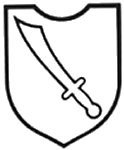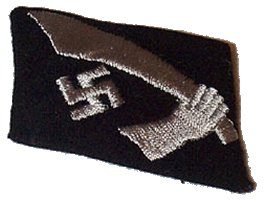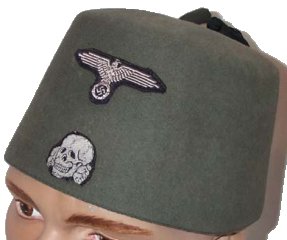
The 13. Waffen-Gebirgs-Division der SS Handschar (kroatische Nr. 1) was formed to use Bosnian Muslims to defend their home region against the partisans and Chetnik forces, the members of the unit included supporters of the Albanian anti-communist organization Balli Kombëtar. Due to their islamic faith they were allowed Imams in the division.
During the training in France, a minor mutiny occured in September 1943, but the training was completed and it returned home in February 1944.
When the German forces retreated from this region September 1944 many of the soldiers remained behind. The unit took on Germans from various smaller units in the Balkans and fought in Croatia and Hungary but was only brigade size. It surrendered to British forces near St. Veit an der Glan at the end of the war.
The first Handschar mutiny occurred in Villefranche de Rouergue on 16-17 September 1943 within SS-Geb.Pi.Btl.13. An infiltrated communist agent started the affair and five German officers were murdered (SS-Obersturmführer Julius-Friedrich Galantha, SS-Obersturmbannführer Oskar Kirchbaum, SS-Obersturmführer Gerhard Kretschmer, SS-Hauptsturmführer Heinrich Kuntz & SS-Obersturmführer Anton Wolf, all from SS-Geb.Pi.Btl. 13). The mutiny was quelled within hours by elements of the battalion loyal to the Germans and order was quickly restored.
Two mutineers were killed in armed fighting: Ferid Dzanic and Lutfija Dizdarevic, fourteen others were shot after court-martial proceedings.
A second Handschar mutiny occured on 21 October 1944 within the Div. Stabsjäger Kompanie. The men simply deserted en masse. The Germans managed to contact the mutineers but the latter refused to return to the division. They later joined the Partisans.
This unit took part in anti-partisan operations in Croatia.
Known war crimes
Soldiers from the division killed 22 Jews in Tuzia in the summer of 1944.
Soldiers from Handschar killed approximately 200 Jews at Rechnitz on 24-25 March 1945. (1)
38 Hanschar soldiers were put on trial in Yugoslavia 20-30 August 1947 for war crimes though only seven of them were charged with specific offenses. All were found guilty, seven were executed and the rest sentenced to prison terms ranging from five years to life in prison. In the end they were released early and the last prisoners were released in 1952, one of them died in prison.
Lineage
Kroatische SS-Freiwilligen-Division (Mar 1943 – July 1943)
Kroatische SS-Freiwilligen-Gebirgs-Division (July 1943 – Oct 1943)
SS-Freiwilligen-Bosnien-Herzegowina-Gebirgs-Division (Kroatien) (Oct 1943)
13. SS-Freiwilligen-Bosnien-Herzegowina-Gebirgs-Division (Kroatien) (Oct 1943 – May 1944)
13. Waffen-Gebirgs-Division der SS Handschar (kroatische Nr. 1) (May 1944 – May 1945)
Commanders
SS-Standartenführer d.R. Herbert von Obwurzer (9 Mar 1943 – 9 Aug 1943)
SS-Brigadeführer Karl-Gustav Sauberzweig (9 Aug 1943 – 19 June 1944)
SS-Brigadeführer Desiderius Hampel (19 June 1944 – 8 May 1945)
Chief of Staff
SS-Sturmbannführer Erich Braun (1 Mar 1943 – 1 July 1944)
SS-Sturmbannführer Einer (? July 1944 – ? July 1944)
SS-Sturmbannführer Johann Boy Petersen (? July 1944 – ? July 1944)
SS-Hauptsturmführer Otto Reuter (1 Aug 1944 – ? 1945)
SS-Sturmbannführer Siegfried Bernhard Sander (1 Mar 1945 – ? Mar 1945)
SS-Sturmbannführer Hamm (? Mar 1945 – ? Mar 1945)
SS-Sturmbannführer Siegfried Bernhard Sander (24 Mar 1945 – ? 1945)
Quartermaster
SS-Sturmbannführer Desiderius Hampel (3 Oct 1943 – 22 Oct 1943)
SS-Sturmbannführer Johann Petersen (? Apr 1944 – 2 July 1944)
SS-Hauptsturmführer Otto Reuter (2 July 1944 – 1 Aug 1944)
SS-Sturmbannführer Johann Petersen (1 Aug 1944 – 1 Mar 1945)
Area of operations
Yugoslavia (Mar 1943 – July 1943)
France (July 1943 – Jan 1944)
Germany (Jan 1944 – Mar 1944)
Yugoslavia (Mar 1944 – Sep 1944)
Hungary (Jan 1945 – Apr 1945)
Austria (Apr 1945 – May 1945)
Manpower strength
Dec 1943 21.065
June 1944 19.136
Dec 1944 12.793
Honor titles
Handschar is the German spelling for Handžar, a Croat term of Turkish origin meaning a scimitar which also featured on the Bosnian coat-of-arms. An armored fist holding a Handschar also appeared on the divisional collar patch, along with a swastika, and Handžar was also the name of the divisional newspaper.
Holders of high awards
Holders of the German Cross in Gold (5)
– Hanke, Hans, 28.02.1945, SS-Sturmbannführer, Fhr. SS-Geb.Jäg.Rgt. 28
– König, Hans, 10.03.1945, SS-Obersturmführer, Chef 7./SS-Geb.Jäg.Rgt. 28
[unit listed as II./SS-Geb.Jäg.Rgt. 28 in Scheibert and I./SS-Geb.Jäg.Rgt. 28 in Lepre]
– Kuhler, Emil, 16.06.1944, SS-Sturmbannführer, Kdr. SS-Geb.Aufkl.Abt. 13
– Liecke, Karl, 28.02.1945, SS-Sturmbannführer, Fhr. SS-Geb.Jäg.Rgt. 27
– Schifferdecker, Hermann, 00.04.1945, SS-Hauptsturmführer, I./SS-Geb.Jäg.Rgt. 27
[not listed in Thomas/Wegmann or Scheibert ; George Lepre’s excellent study Himmler’s Bosnian Division: The Waffen-SS Handschar Division, 1943-1945 is footnoted: “Letters to the author from Karl Wambsganss [division adjutant] and Hermann Schifferdecker dated 16 April and 20 June 1992.”]
Holders of the German Cross in Silver (1)
– Wambsganß, Karl, 30.04.1945, SS-Hauptsturmführer, Adjutant 13. W-Geb.Div. d. SS “Handschar”
Holders of the Knight’s Cross (5, all unofficial/unconfirmed)
– Hampel, Desiderius 03.05.1945 SS-Brigadeführer und Generalmajor der W-SS Kdr Kgr 13. Waffen-Geb.Div der SS „Handschar“
[no proof in Bundesarchiv ; in a letter Krätschmer wrote to von Seemen in 1980 it is stated that H. got the KC the same day as Liecke and Hanke ; according von Seemen bestowal/award by General de Angelis ; case treated by the Ordenskommission of the OdR in 1980 with decision by Fellgiebel : „ja, 3.5.1945“ ; own remark by Fellgiebel : no authorization to award]
– Hanke, Hans 03.05.1945 SS-Obersturmbannführer Kdr Waffen-Geb.Jäg.Rgt der SS 28 (kroat. Nr. 2)
[no proof in Bundesarchiv ; same situation like Hampel, see above]
– Kinz, Helmut, 03.05.1945 SS-Hauptsturmführer und Hauptmann der Schupo Kdr. SS-Aufkl.Abt 13
[no evidence in Bundesarchiv; not mentioned in the files of the OdR; according to von Seemen, supposedly awarded by General der Artillerie Maximilian de Angelis, OB 2. Pz.Armee, on the basis of the authorization granted on 03.05.1945; Fellgiebel later remarked: “A justification for the award was not available”]
– Liecke, Karl 03.05.1945 SS-Obersturmbannführer und Oberleutnant der Schupo Kdr Waffen-Geb.Jäg.Rgt der SS 27 (kroat. Nr. 1)
[no proof in Bundesarchiv ; same situation like Hampel, see above ; case treated by Ordenskommission of the OdR before 1973 and decided „Yes“ ]
– Stenwedel, Albert 03.05.1945 SS-Sturmbannführer Kdr II./Waffen-Geb.Jäg.Rgt der SS 27 (kroat. Nr. 1)
[no proof in Bundesarchiv ; no mentionned in the files of the OdR Ordenskommission ; according von Seemen bestowal/award by General de Angelis based on a right to award dated 03.05.1945 (Ermächtigungserlass) which wasn’t actual at that time anymore ; remark by Fellgiebel : no authorization to award]
Holders of other notable badges & decorations
Holders of the Anti-Partisan Badge in Bronze (1)
– Wirkert, Georg, ??, SS-Rottenführer, 13. Waffen-Geb.Div. dSS “Handschar”
Order of battle (1943)
Stab
Kroatisches SS-Freiwilligen-Gebirgsjäger-Regiment 1
Kroatisches SS-Freiwilligen-Gebirgsjäger-Regiment 2
Kroatisches SS-Freiwilligen-Gebirgs-Artillerie-Regiment
Kroatische SS-Kavallerie-Abteilung
Kroatische SS-Kradschützen-Bataillon
Kroatische SS-Radfahr-Bataillon
Kroatische SS-Panzer-Abteilung
Kroatische SS-Panzerjäger-Abteilung
Kroatische SS-Flak-Abteilung
Kroatische SS-Pionier-Bataillon
Kroatische SS-Nachrichten-Abteilung
Order of battle (spring 1944)
Stab
SS-Freiwilligen-Gebirgsjäger-Regiment 27
SS-Freiwilligen-Gebirgsjäger-Regiment 28
SS-Freiwilligen-Gebirgs-Artillerie-Regiment 13
SS-Aufklärungs-Abteilung 13
SS-Panzerjäger-Abteilung 13
SS-Pionier-Bataillon 13
SS-Nachrichten-Abteilung 13
SS-Freiwilligen-Flak-Abteilung 13
SS-Gebirgsjäger-Ausb.u.Ers.Bataillon 13
Panzer-Aufklärungs-Zug
Order of battle (1944)
SS-Waffen-Gebirgsjäger-Regiment der SS 27
SS-Waffen-Gebirgsjäger-Regiment der SS 28
SS-Waffen-Artillerie-Regiment der SS 13
SS-Panzerjäger-Abteilung 13
SS-Aufklärungs-Abteilung (mot) 13
Waffen-Gebirgs-Pionier-Abteilung der SS 13
Waffen-Gebirgs-Nachrichten-Abteilung der SS 13
Waffen-Flak-Abteilung der SS 13
SS-Nachrichten-Abteilung 13
Kroatische SS-Radfahr-Bataillon
Kroatische SS-Kradschützen-Bataillon
SS-Divisionsnachschubtruppen 13
Versorgungs-Regiment Stab 13
SS-Verwaltungs-Bataillon 13
SS-Sanitäts-Abteilung 13
SS-Krankenkraftwagenzug
SS-Freiwilligen-Gebirgs-Veterinär-Kompanie 13
SS-Feldpostamt 13
SS-Kriegsberichter-Zug 13
SS-Feldgendarmerie-Trupp 13
SS-Feldersatz-Bataillon 13
SS-Kraftfahr-Lehr-Abteilung 13
Notable members
Hermann Behrends (SS-Gruppenführer, Reichstag deputy, deupty head of the Volksdeutsche Mittelstelle, VOMI, Höhere SS und Polizeiführer Serbien, Sandschack und Montenegro 1944)
Officers serving in the Einsatzgruppen and Concentration Camps
Concentration Camps 9
(includes officers serving in the Einsatzgruppen or Concentration Camps either prior to or after service in this unit)
Insignia
The tactical marking of the division was an arm with a scimitar curved through the SS runes.
Members of this division was not allowed to use the SS runes and in late 1943 a collar tab with a swastika and a hand holding a simitar was introduced.
(Courtesy of The Ruptured Duck)
A felt fez was used instead of the regular visored caps, a field-grey fez was used with the battle dress and a maroon fez with the dress uniform.
Waffen-SS Fez (service)
(Courtesy of The Ruptured Duck)
Soldiers of the Handschar division wearing the special collar tab and fez
Footnotes
1. “Murderous Elite: The Waffen-SS and its complete record of war crimes” by James Pontolillo, page 56.
Sources used
Christopher Ailsby – Hitler’s Renegades: Foreign nationals in the service of the Third Reich
John R. Angolia – Cloth insignia of the SS
Roger James Bender & Hugh Page Taylor – Uniforms, Organization and History of the Waffen-SS, vol 3
Georges M. Croisier – Waffen-SS (PDF)
Terry Goldsworthy – Valhalla’s Warriors: A history of the Waffen-SS on the Eastern Front 1941-1945
Jill Halcomb & Wilhelm P. B. R. Saris – Headgear of Hitler’s Germany, Vol 2
Steve Kane – Waffen-SS Forces in the Balkans: A checklist (in World War II Journal, Vol 7)
Dr. K-G Klietmann – Die Waffen-SS: eine Dokumentation
David Littlejohn – Foreign Legions of the Third Reich, vol 3
James Lucas – Hitler’s Mountain Troops: Fighting at the extremes
Kurt Mehner – Die Waffen-SS und Polizei 1939-1945
Antonio J. Munoz – The East came West: Muslim, Hindu and Buddhist Volunteers in the German Armed Forces 1941-1945
Marc J. Rikmenspoel – Waffen-SS Encyclopedia
George H. Stein – The Waffen-SS: Hitler’s Elite Guard at War 1939-1945
James C. Steuard – Tactical Markings of the Waffen-SS, Part III (in AFV News Vol 3, No 3)
Frank Thayer – SS Foreign volunteer collar insignia and their reporductions (in The Military Advisor, Vol 4 No 2)
Gordon Williamson – German Security and Police Soldier 1939-45
Gordon Williamson – The Waffen-SS: 11. to 23. Divisions
Mark C. Yerger – Waffen-SS Commanders: The Army, corps and divisional leaders of a legend (2 vol)
Reference material on this unit
Ilai Benino – Singa Bosnia: Sejarah Divisi SS Handschar, 1943-45 (Jakarta, Gaco Books, 2009)
Mirko D. Grmek & Louise L. Lambrichs – Revoltes de villefranche: Mutinerie d’un Bataillon de Waffen-SS Septembre 1943
George Lepre – Himmler’s Bosnian Division: The Waffen-SS Handschar Division 1943-1945
Antonio J. Munoz – The East came West: Muslim, Hindu and Buddhist volunteers in the German Armed Forces
Amandine Rochas – La Handschar: Histoire d’une division de Waffen-SS bosniaque


